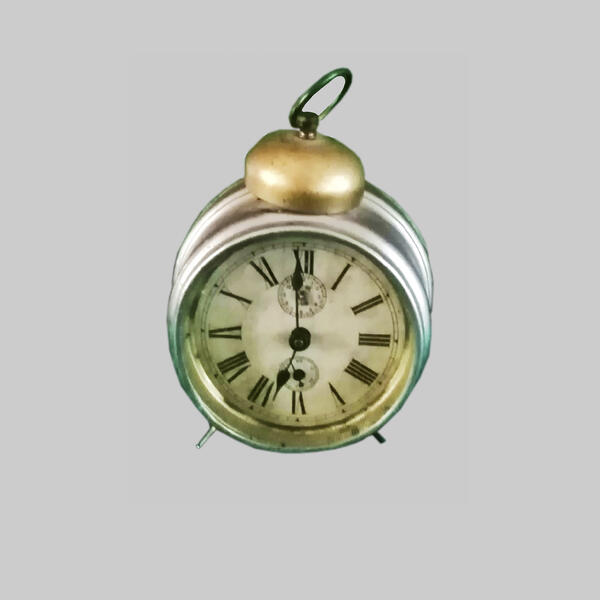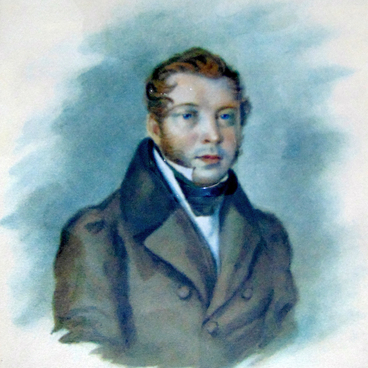An alarm clock, made by an unknown German company in the early 20th century, stands out immediately on a table in the ‘Large sitting room’. The table used to be in the office of Olga Aksakova, granddaughter of the writer Sergey Aksakov and founder of the clinic in the village of Nadezhdino. That is why we can assume that this clock once sat on a table in the clinic’s office.
The clock’s mechanism is made of yellow metal, and it has a cardboard dial with Roman numerals, with two smaller dials inside, one under the digit XII, and second under the digit VI. The top mini-dial with divisions from 10 to 60 is used to measure independent time intervals in minutes, and the bottom one with divisions from 2 to 12 allows to measure time intervals in hours. On the back side of the alarm clock there are cranks for winding and adjusting the clockwork. As of the present day, this clock is not in working condition.
At the specified time, the alarm clock emits a piercing sound, which is how it got its Russian name — ‘wake-up clock’ — as it is primarily used to make sure one gets up in time. Allegedly, a prototype of the alarm clock dates back to the 4th century B.C., first invented by the ancient Greek philosopher Plato. His design was composed of three vessels, which were connected to each other by tubes. When one vessel was filled up, the water would rapidly pour over into the next one. The lower vessel had an ancient equivalent of a horn installed into it. Once released into the last vessel, the water quickly forced the air out of it directly into the horn, creating a loud noise. With this mechanism Plato signaled his students about the start of a lecture.
In the 15th or 16th century, the great Italian artist and scientist Leonardo da Vinci also invented a device that can be considered a prototype of an alarm clock. It had only two vessels; the water dripped from the top vessel to the bottom one and as it filled up, it powered a mechanism that would lift the sleeping person’s legs. The design of a more familiar to us mechanical alarm clock was first developed by the American clockmaker Levy Hutchins in 1787, but unfortunately, it had a major drawback: it would only ring at 4 AM. Finally, in 1847, the design of the alarm clock, which can be adjusted at any time, was patented by the French inventor Antoine Radier.
The clock’s mechanism is made of yellow metal, and it has a cardboard dial with Roman numerals, with two smaller dials inside, one under the digit XII, and second under the digit VI. The top mini-dial with divisions from 10 to 60 is used to measure independent time intervals in minutes, and the bottom one with divisions from 2 to 12 allows to measure time intervals in hours. On the back side of the alarm clock there are cranks for winding and adjusting the clockwork. As of the present day, this clock is not in working condition.
At the specified time, the alarm clock emits a piercing sound, which is how it got its Russian name — ‘wake-up clock’ — as it is primarily used to make sure one gets up in time. Allegedly, a prototype of the alarm clock dates back to the 4th century B.C., first invented by the ancient Greek philosopher Plato. His design was composed of three vessels, which were connected to each other by tubes. When one vessel was filled up, the water would rapidly pour over into the next one. The lower vessel had an ancient equivalent of a horn installed into it. Once released into the last vessel, the water quickly forced the air out of it directly into the horn, creating a loud noise. With this mechanism Plato signaled his students about the start of a lecture.
In the 15th or 16th century, the great Italian artist and scientist Leonardo da Vinci also invented a device that can be considered a prototype of an alarm clock. It had only two vessels; the water dripped from the top vessel to the bottom one and as it filled up, it powered a mechanism that would lift the sleeping person’s legs. The design of a more familiar to us mechanical alarm clock was first developed by the American clockmaker Levy Hutchins in 1787, but unfortunately, it had a major drawback: it would only ring at 4 AM. Finally, in 1847, the design of the alarm clock, which can be adjusted at any time, was patented by the French inventor Antoine Radier.



